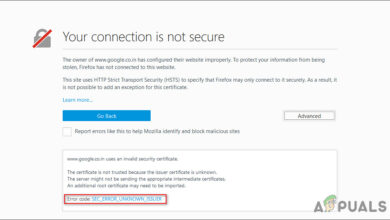Fix: Firefox is not responding
A surprising amount of users report having problems with Mozilla Firefox on Windows 10, considering the fact that this browser is widely considered the stablest out of the bunch. Most users complain about getting frequent freeze ups with “Not Responding” messages.

Although this problem is by no means exclusive to Windows 10, a lot of users report that it first started occurring after they installed a major update like Anniversary update on Windows 10.
Although the reasons why your Firefox browser might malfunction are diverse, there are a few common culprits that seem to be responsible for the freezes and crashes of the browser:
- Malicious or intrusive files made their way into the installation folder or in the cache memory
- Intrusive or untested plug-ins are causing the instability.
- Too many freeware converters are running at once within Firefox (pdf to word, jpeg to png, word to pdf, etc.)
- Firefox profile folder doesn’t have the right to create files (read-only permission)
The good news is that regardless of the culprit that is causing the instability, you will resolve the issue before you finish troubleshooting with the methods featured in this article. Below you have a collection of fixes that users in a similar situation have used to resolve the issue. Please follow each potential fix in order until you encounter a method that is successful in solving the problem for your particular situation.
Method 1: Force close restart and update
If you rarely experience instability, a temporary fix will be to force close Firefox and initiate a restart. If the error is caused by an internal bug or by a corrupted internal file forcing the client to update will resolve most of those errors. Once Mozilla Firefox becomes unresponsive, you won’t be able to close it the conventional way (via the close icon). However, you can easily close the program through Task Manager by pressing Ctrl + Shift + Esc. Then, go to the Processes tab, select Firefox and click the End task button.
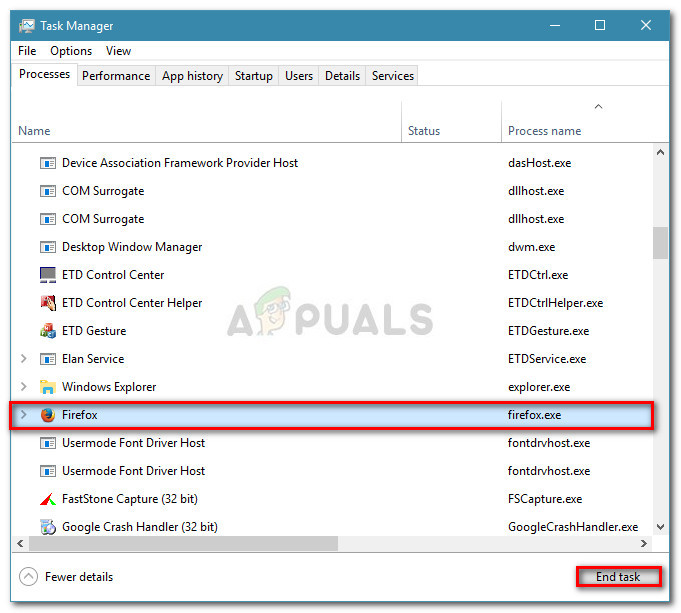
Once you manage to close the unresponsive application, go ahead an restart your operating system. At the next startup, open Firefox again and click the Menu icon in the top-right corner. Then, go to Help and click on About Firefox. Wait until the system checks if you have the latest version. If a new version is available, click on Restart and update Firefox and wait for the process to complete.

At the next startup, keep an eye out for any unresponsive periods. If you’re still getting occasional freezes or crashes, move down to the next troubleshooting strategies below.
Method 2: Check for the required access rights
A common reason why the Firefox browser becomes unresponsive is when the profile folder doesn’t have write permissions. This is quite a common occurence if Firefox uses a profile from a file system that was previously mounted with read-only permissions.
Luckily, you can easily change the settings of the profile folder to configure the proper permissions. Here’s how you can do this:
- Press Windows key + R to open up a Run box. Then, type “%APPDATA%\Mozilla\Firefox\Profiles\” and hit Enter to open the folder containing the profile folders of Firefox.

- Go up one folder to reach the Firefox folder, then right-click on the Profiles folder and choose Properties.
- In the Properties window of Profiles, go to the General tab and make sure that the Read-only box not checked and hit the Apply button.

- If you found that the Read-only attribute was checked and you modified it go ahead reboot your computer. At the next startup, start using Firefox again and monitor it for any signs of unresponsiveness.
If you are still encountering periods where the browser becomes unresponsive, move down to the next method below.
Method 3: Clearing the Cache & Cookies
Another popular fix that has enabled a lot of users to get rid of unresponsive periods was clearing the cache. By eliminating cached web page versions and cookies, you successfully eliminate a lot of potential culprits that might be causing the problem.
Here’s a quick guide on how to resolve unresponsive periods in Firefox by clearing the cache and Cookies:
- Open Firefox and go to menu icon (top-right corner), then click on Options.
- Then, go to the Privacy & Security tab, scroll down to Cached Web Content and click on the Clear Now button.

- Close FireFox and restart your computer. At the next startup, open Firefox again and see whether the unresponsive periods have been resolved.
If you are still getting the occasional Firefox freeze or crash, move over to the next method below.
Method 4: Start Firefox in Safe Mode and disable extensions, themes or hardware acceleration
Firefox extensions and custom themes are other reason why users get unresponsive periods with their browser. If you rely on a lot of Firefox extensions, uninstalling all your extensions only to find out that they are not to blame for your problem is a huge timewaster.
However, you can eliminate this risk by starting Firefox in Safe Mode and see whether the unresponsive periods stop. While in Safe Mode, Firefox will run with all the extensions automatically disabled. On top of this, hardware acceleration will be turned off and any custom theme will be replaced with the default one. This will help you determine if the issue is caused by one of the extensions or themes that you’re currently using. Else the problem is located elsewhere.
Here’s a quick guide on launching Firefox in Safe mode and take action if one of the extensions is causing the instability:
- Open Firefox, click on the menu icon (top-right corner). Then, click on the Help icon (question mark icon) and then click on Restart with Add-ons Disabled.
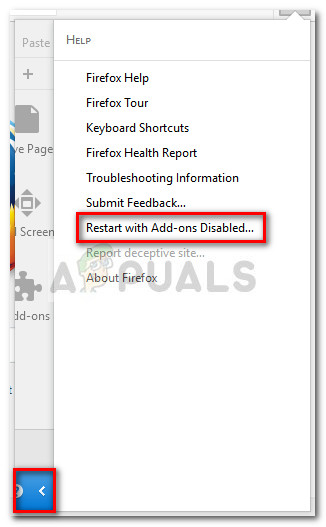 Note: You can also start Firefox directly in Safe Mode by holding the Shift key while double-clicking on Firefox.
Note: You can also start Firefox directly in Safe Mode by holding the Shift key while double-clicking on Firefox. - At the newly appeared prompt, click the Restart button, then click on Start in Safe Mode and wait until Firefox restarts in safe mode.
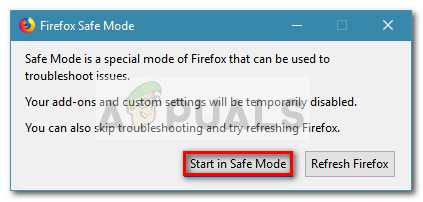
- Use Firefox in Safe Mode for a while and see whether you encounter the same instability. If the unresponsive periods don’t appear while you surf in Safe mode, you can turn your attention towards three culprits: extensions, themes, or hardware acceleration.
Note: If you don’t encounter any unresponsive periods while you’re in Safe Mode, move directly to the method below.
If your problem did not occur in Safe Mode, the issue is probably caused by an extension, theme or hardware acceleration. With this in mind, exit Continue with the next three repair strategies to pinpoint the cause of the issue:
Disabling hardware acceleration
The latest Firefox version will have hardware acceleration enabled by default. This enhances the performance on most systems, but some older rigs might become unstable while this feature is enabled. Luckily, you can easily turn off hardware acceleration and see whether it fixes the issue for good. Here’s a quick guide on how to disable hardware accelerations:
- Open Firefox, click on the menu icon (top-right corner) and then click on Options.
- In the Options menu, go to the General pane and scroll down to the Performance tab and uncheck the box associated with Use recommended performance settings checkbox.
- Next, uncheck the box associated with Use hardware acceleration when available.

- Restart Firefox and continue using Firefox normally to see if the issue repeats. If you’re still encountering unresponsiveness, continue to the next tactic.
Revert to the Default Theme
Custom themes are fairly common culprits that might cause instability. You can easily figure out if the custom theme that you are using is causing the issue by reverting to the default one. Here’s a quick guide on how to do this:
- Open Firefox and click the menu button (top-right corner). Then, click on Add-ons and wait for the Add-ons Manager to open.
- In the Add-ons Manager, go to the Themes panel an click on the Enable button associated with the Default theme.

- Restart Firefox and see you experience the same unresponsive behavior at the next startup. If you are, continue with the next repair strategy.
Disable all extensions
If you eliminated the other possibilities that might cause your Firefox browser to function normally, you might want to turn your attention towards the Add-ons that you have active.
To figure out which extension is causing the instability, you’ll need to disable each one systematically. Or better yet, you can disable all extensions at once and then re-enable each one gradually until you identify the culprit. Here’s a quick guide on disabling all extensions:
- Open Firefox and click the menu icon (top-right corner). Then, click on Add-ons to open the Add-ons manager.
- In the Add-ons Manager tab, click the Extension icon.
- Disable and active extension that you suspect might be causing the instability by selecting it and clicking the Disable Button. Repeat this procedure with each extension that you suspect.
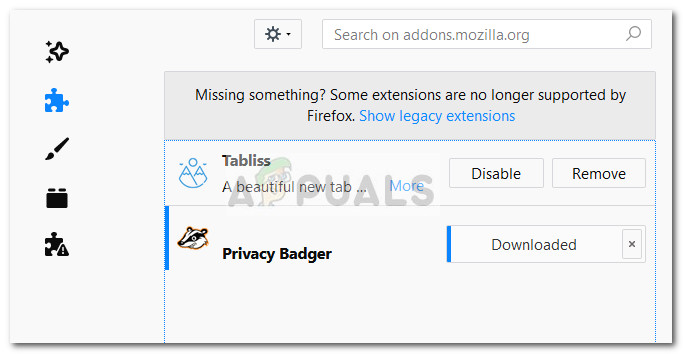
- Restart Firefox and see if you still experience unresponsiveness.
If you find that the problem still occurs even after you followed every repair strategy explained in Method 4, continue with Method 5.
Method 5: Enabling Hardware Acceleration
Some users that were constantly experiencing periods of unresponsiveness in Firefox have managed to resolve the issue by enabling the use of hardware acceleration in the Performance tab. Supposedly, the periods of unresponsiveness happen because certain systems don’t have the resources to process the graphical elements that the user requires without using the help of hardware acceleration.
Here’s a quick guide on enabling hardware acceleration from the Options menu of Firefox:
- Open Firefox, click the menu icon (top-right corner) and click on Options.
- Go to the General tab and scroll down to the Performance menu. Then, uncheck Use recommended performance settings and check the box associated with Use hardware acceleration when available.

- Close Firefox and restart your PC. At the next startup, open Firefox again and keep an eye out for any periods of unresponsiveness.




